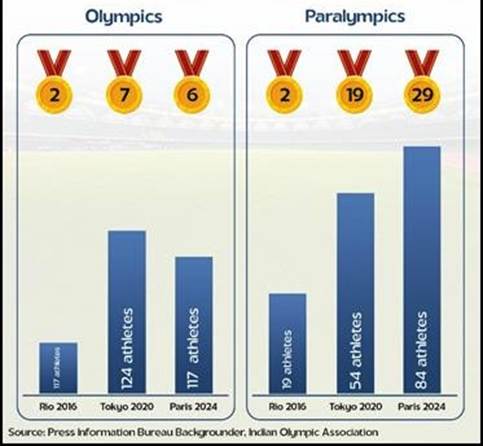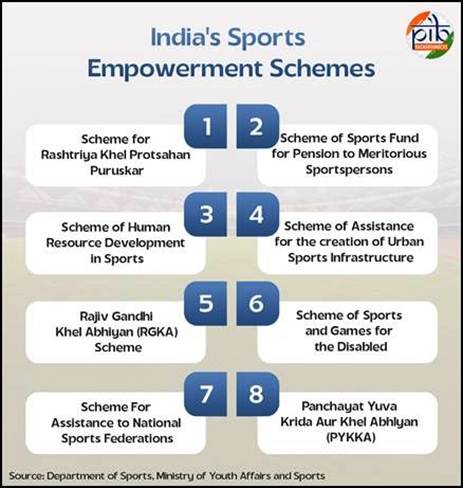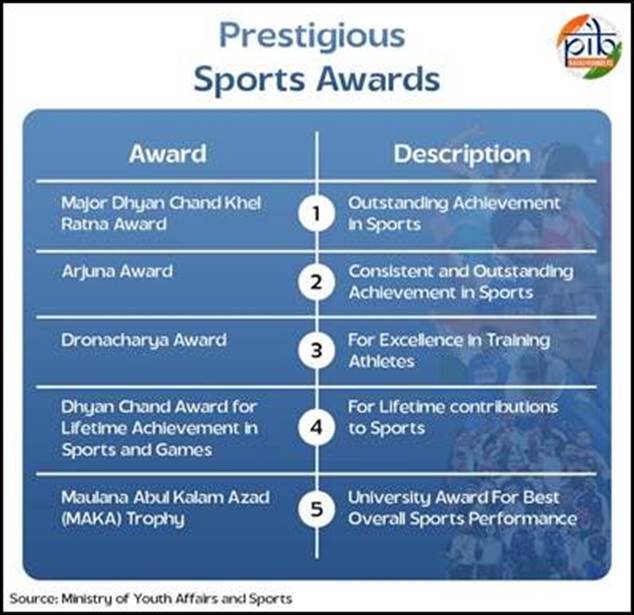Content:
- Khelo Bharat Niti 2025
Khelo Bharat Niti 2025
Strategic Vision and Integration
- Aligned with Viksit Bharat 2047, this is a transformative policy integrating sports, education, inclusion, economy, and diplomacy.
- Anchored in the National Education Policy (NEP) 2020 — promotes curricular integration of sports, lifelong fitness habits, and physical education training.
- Envisions India as a global sporting powerhouse by 2036 (Olympics host + Top-10 nation) and Top-5 by 2047.
Relevance : GS 2 (Governance, Welfare Schemes and Inclusion)
Budgetary Commitment
- FY 2025–26 Sports Budget: ₹3,794 crore → 130.9% increase over FY 2014–15.
- ₹2,191 crore for Central Sector Schemes.
- ₹1,000 crore for Khelo India Programme alone.

Grassroots to Elite: Institutional Mechanisms
Khelo India Programme – Flagship Engine
- Launched: 2016–17, Extended: 2021, Budget till now: ₹3,790.5 crore.
- Achievements:
- 326 sports infra projects worth ₹3,124.12 crore.
- 1,045 Khelo India Centres (KICs), 34 KISCEs, 306 accredited academies.
- 2,845 Khelo India Athletes (KIAs) supported with training, diet, equipment, stipend, and medical care.
KIRTI: Early Talent Identification
- Khelo India Rising Talent Identification (KIRTI) for children aged 9–18.
- Uses 174 Talent Assessment Centres (TACs).
- Pipeline to global elite training, Olympic medal goals.

Annual Games Ecosystem
- Includes:
- Khelo India Youth Games (KIYG) – 27 sports by 2025.
- University Games, Para Games, Winter Games – 17 editions, 50,000+ athletes.
- Khelo India School Games evolved into KIYG (backed by IOA).
- 2023 & 2025 Para Games: 1,300+ athletes each.

Policy Innovations and Systemic Reforms
- Holistic athlete support: Nutrition, sports science, psychology, tech, and injury care.
- National Sports Federations (NSFs): Enhanced governance and accountability.
- Private Investment: Boost via PPP, CSR, sports startups, and creative finance.
- Sports Tourism and international event hosting for economic gains.
Equity, Empowerment, and Inclusion
- Women, tribal groups, disabled athletes prioritized.
- Siddi community success in athletics, boxing, judo with state support.
- Para-athlete Rohit Kumar highlights equal rewards, policy integration with education.
Sports-Education Nexus: A New Ecosystem
- National Sports University, Imphal (est. 2018):
- Education in sports sciences, coaching, technology, management.
- Global collaboration with Canberra & Victoria Universities.
- Motto: “Sports Excellence through Education, Research and Training.”

New Frontiers and Diaspora Engagement
- 1st Khelo India Water Sports Festival (Aug 2025) at Dal Lake, Srinagar.
- Features 5 water sports, 400+ athletes.
- Expands into water sports excellence and regional talent.
- Engages Indian diaspora via international talent recognition and collaboration.
Policy Impact: Cultural Shift in Sports Perception
- From “extra-curricular” to mainstream career pathway.
- Sports now seen as a tool for:
- Nation-building (unity, youth engagement)
- Health and wellness (institutional fitness indices)
- Social mobility and pride (rural & marginalized outreach)
Outlook: Toward Olympic Glory
- India’s approach is no longer medal-centric but ecosystem-centric.
- Khelo Bharat Niti 2025 fosters “Sports for All, Excellence for Few” model.
- Positioned to host Olympics 2036, powered by:
- Mass participation + elite excellence
- Infrastructure + human capital synergy
- Institutional coherence + societal mindset shift
Obesity in India and the Role of Sports Policy
- Rising Obesity Trends:
India faces a dual burden of malnutrition and obesity. NFHS-5 (2019–21) shows 24% of women and 22.9% of men (15–49 yrs) are overweight or obese—up from ~20% in NFHS-4.
- Urban Youth at Risk:
Sedentary lifestyles, screen time, and junk food consumption have led to increased obesity among school and college students, especially in metros.
- Non-Communicable Disease Burden:
Obesity is a major risk factor for NCDs like Type 2 diabetes, hypertension, and cardiovascular diseases. WHO warns that India may face a 10% NCD increase if youth inactivity persists.
- Fitness & Khelo India’s Role:
Khelo India promotes Fitness Assessment Index in schools, encouraging active lifestyles and early health monitoring of children.
- Khelo Bharat Niti 2025 – Health Integration:
Explicitly aims to embed fitness as a national movement, encouraging daily physical activity and structured sports participation from grassroots level.
- NEP 2020 Alignment:
Sports and physical education are now part of the school curriculum, promoting lifelong fitness habits and reducing childhood obesity risks.
- Infrastructure & Accessibility:
1,045+ Khelo India Centres and grassroots competitions create local access to physical activity spaces, especially in underserved regions.
- Behavioral Change through Sports:
National campaigns under Khelo Bharat aim to reshape youth attitudes toward fitness, making sports aspirational and habitual.
- Community-Level Solutions:
Initiatives like the Khelo India Fitness App, local tournaments, and school-level sports are geared toward reversing sedentary culture.
- Long-Term Vision:
Tackling obesity aligns with India’s broader public health goals under Ayushman Bharat and National Health Policy, with sports as a preventive tool.
Facts & Figures Supporting Khelo Bharat Niti 2025
- India’s Youth Demographic
- India’s population as of April 2025 is around 1.46 billion, with 68% in the working-age group (15–64 years) and 26% aged 10–24.
Source: UNFPA State of World Population Report 2025
- India’s population as of April 2025 is around 1.46 billion, with 68% in the working-age group (15–64 years) and 26% aged 10–24.
- Fertility Rate and Demographic Transition
- India’s Total Fertility Rate has declined to 1.9, below the replacement level of 2.1.
Source: National Family Health Survey (NFHS-5) and UNFPA 2025 Update
- India’s Total Fertility Rate has declined to 1.9, below the replacement level of 2.1.
- Union Sports Budget FY 2025–26
- ₹3,794.30 crore allocated to the Ministry of Youth Affairs and Sports, a ₹351.98 crore increase over FY 2024–25.
Source: Union Budget 2025–26, Ministry of Finance
- ₹3,794.30 crore allocated to the Ministry of Youth Affairs and Sports, a ₹351.98 crore increase over FY 2024–25.
- Khelo India Programme Allocation
- ₹1,000 crore allocated to Khelo India, marking its highest-ever funding.
Source: Union Budget 2025–26, Ministry of Youth Affairs and Sports
- ₹1,000 crore allocated to Khelo India, marking its highest-ever funding.
- NSFs and SAI Funding
- National Sports Federations received ₹400 crore; Sports Authority of India was allocated ₹830 crore.
Source: Ministry of Youth Affairs and Sports Budget Highlights 2025
- National Sports Federations received ₹400 crore; Sports Authority of India was allocated ₹830 crore.
- Sports Economy Projections
- India’s sports industry projected to grow from $52 billion (2024) to $130 billion by 2030 at a 14% CAGR.
Source: FICCI–EY India Sports Industry Report 2024
- India’s sports industry projected to grow from $52 billion (2024) to $130 billion by 2030 at a 14% CAGR.
- Sports Equipment Sector Growth
- Indian sports equipment market expected to reach $100 billion by 2027, up from $27 billion in 2020.
Source: India Brand Equity Foundation (IBEF) and DPIIT Data
- Indian sports equipment market expected to reach $100 billion by 2027, up from $27 billion in 2020.
- SAI Talent Development Model
- SAI supports athletes aged 8–25 under schemes like NSTC, STC, COE, and SAG for grassroots-to-elite progression.
Source: Sports Authority of India Annual Report 2024
- SAI supports athletes aged 8–25 under schemes like NSTC, STC, COE, and SAG for grassroots-to-elite progression.
- 38th National Games – 2025
- Held in Uttarakhand from Jan 28–Feb 14, 2025, with over 10,000 athletes in 35 disciplines.
Source: Indian Olympic Association and Ministry of Sports
- Held in Uttarakhand from Jan 28–Feb 14, 2025, with over 10,000 athletes in 35 disciplines.
- India’s Olympic and Commonwealth Aspirations
- India formally expressed interest in hosting the 2036 Olympics; Ahmedabad is bidding for the 2030 Commonwealth Games.
Source: Indian Olympic Association and International Olympic Committee communication, 2023–24
Conclusion :
- Strategic Shift: Khelo Bharat Niti 2025 transforms sports from a hobby into a structured, career-oriented, and nation-building tool aligned with NEP 2020 and the Viksit Bharat vision.
- Inclusive & Aspirational: By focusing on grassroots talent, infrastructure, and equity, it empowers youth, women, and marginalized groups, making sports accessible and aspirational.
- Global Ambition, Local Action: With robust funding and systemic reforms, the policy positions India to emerge as a global sporting power by 2036, while promoting health, fitness, and social cohesion at the community level.



